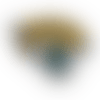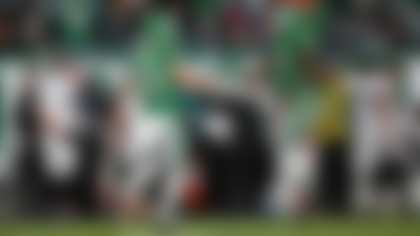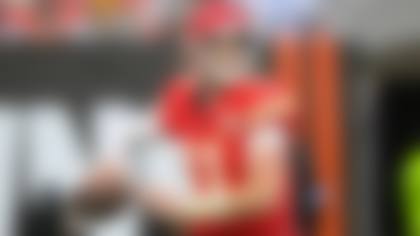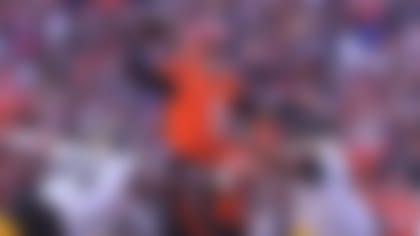Why provide instant grades on the selections of prospects who have yet to take an NFL snap? Well, you're reading this, aren't you? Considering the makeup of every roster and the factors surrounding each pick, Gennaro Filice and Dan Parr attempt a division-by-division assessment of the 2020 . Keep in mind that these grades are based on draft hauls alone -- picks traded for veteran players were not taken into account. Below is Dan's review of the AFC South.
NOTABLE SELECTIONS
BEST PICK: Michael Pittman, WR, USC
Indianapolis Colts, Round 2, No. 34 overall
Chris Ballard didn't have a first-rounder after trading the No. 13 overall pick to the 49ers for DeForest Buckner, but he was still able to fill the team's biggest need and get solid value out of his top selection. Pittman's not going to wow anyone with speed and quickness. That's not his game. He has the size and toughness to be a perfect complement to T.Y. Hilton in Indy's receiving corps, though. The former Trojan checks in at 6-foot-4, 223 pounds. He will be able to win 50-50 battles and should quickly become one of Philip Rivers' favorites.
MOST SURPRISING PICK: Isaiah Wilson, OT, Georgia
Tennessee Titans, Round 1, No. 29 overall
This was not a total shock. There were plenty of rumblings leading up to the draft that Wilson might go late in Round 1. I know the Titans had a need at right tackle after the departure of Jack Conklin, but it was still a little surprising to them take a shot on NFL Network draft guru with the 29th overall pick. Tennessee is in win-now mode coming off its run to the AFC Championship Game, but Wilson might require some patience early as he works on becoming more consistent in his technique and footwork.
BIGGEST SLEEPER: Ben Bartch, OT, St. John's (Minn.)
Jacksonville Jaguars, Round 4, No. 116 overall
Now this gamble on a developmental tackle prospect was far more palatable for me, since it came in Round 4. Bartch, who played his college ball for Division III St. John's in Minnesota, gained some notoriety in the past few months for sharing that helped the converted tight end put on 75-plus pounds over the course of his college career, but there's far more to this prospect than disgusting concoctions. (Anyone interested in a nice glass of Gatorade, eggs and cottage cheese?) He more than held his own against a big step up in competition at the in January. He's probably not a Day 1 starter, but it won't be a surprise if he becomes a long-time staple on the Jacksonville front five with the proper grooming from the coaching staff.
TEAM GRADES
NOTE: Draft classes are ranked from best to worst within the division.
» Round 1: (No. 9 overall) C.J. Henderson, CB, Florida; (20) K'Lavon Chaisson, Edge, LSU.
» Round 2: (42) Laviska Shenault, WR, Colorado.
» Round 3: (73) DaVon Hamilton, DT, Ohio State.
» Round 4: (116) Ben Bartch, OT, St. John's (Minn.); (137) Josiah Scott, CB, Michigan State; (140) Shaquille Quarterman, LB, Miami.
» Round 5: (157) Daniel Thomas, S, Auburn; (165) Collin Johnson, WR, Texas.
» Round 6: (189) Jake Luton, QB, Oregon State; (206) Tyler Davis, TE, Georgia Tech.
» Round 7: (223) Chris Claybrooks, CB, Memphis.
Jacksonville came into this draft in rebuilding mode and did a fine job of adding a boatload of talent while also filling most of its top needs. There was a glaring void at corner following the trades of and , so the Henderson pick made plenty of sense -- and the same goes for the Chaisson selection, with Yannick Ngakoue wanting out of town. Landing the second-best corner and edge rusher in the draft? That'll work. Shenault's stock took a hit during the evaluation process due to durability concerns. He offers a lot of upside but a lower floor, too. If it all comes together for him, the Jaguars could come away with three first-round values from this draft. Hamilton went a little earlier than expected, but has a chance to develop into a starter, and we loved the Bartch pick. Don't sleep on the undersized Scott as a future starting nickel corner, either. We wouldn't have minded seeing the Jags gamble on a prospect with a little more upside than Quarterman late in Round 4, but he should be a decent backup at inside 'backer. GM Dave Caldwell added more depth at positions of need later on Day 3, but the main takeaway here is he ended up tying for the league-high by drafting eight players from NFL Network draft expert Daniel Jeremiah's top 150 prospects, including three of his top 36. This is good news for Duval County.
» Round 2: (No. 34 overall) Michael Pittman, WR, USC; (41) Jonathan Taylor, RB, Wisconsin.
» Round 3: (85) Julian Blackmon, S, Utah.
» Round 4: (122) Jacob Eason, QB, Washington.
» Round 5: (149) Danny Pinter, OG, Ball State.
» Round 6: (193) Robert Windsor, DT, Penn State; (211) Isaiah Rodgers, CB, Massachusetts; (212) Dezmon Patmon, WR, Washington State; (213) Jordan Glasgow, LB, Michigan.
There was no action for Indy in Round 1 after dealing its top pick to the Niners for , but the got busy on Day 2, making a couple selections that should bring smiles to the faces of and his many children. Pittman might even remind Rivers of his old go-to guy with the , Vincent Jackson. The former Trojan has the size to go up and get it. Now, close your eyes for a second and imagine Taylor running behind and Co. ... Do you see a mess of defenders being pushed backward and a bruising back pummeling them? I do. Indianapolis could soon be home to the league's model power run game after Taylor, who racked up 6,000-plus rushing yards in three college seasons, joins forces with that front five. The Blackmon selection didn't have the same sizzle as Chris Ballard's first two picks. It seemed a little early for my taste, given his inconsistency in his first season after moving from corner to safety, but I can understand wanting to add depth in the secondary. Some folks were expecting Eason to go in Round 2, so we can't argue with the value in the fourth round. He gets to sit behind Rivers -- and this won't be a bad pick even if he never becomes more than a decent backup, given how late the were able to get him. Glasgow has a chance to carve out a role as a special-teams ace. It would have been nice to see Indy add another young edge rusher at some point.
» Round 1: (No. 29 overall) Isaiah Wilson, OT, Georgia.
» Round 2: (61) Kristian Fulton, CB, LSU.
» Round 3: (93) Darrynton Evans, RB, Appalachian State.
» Round 5: (174) Larrell Murchison, DT, North Carolina State.
» Round 7: (224) Cole McDonald, QB, Hawaii; (243) Chris Jackson, DB, Marshall.
With 's departure leaving a hole at right tackle, GM Jon Robinson found a massive human to fill it. At 6-6, 350 pounds, Wilson can maul folks off the edge, but the technique and footwork are going to have to be more consistent for this pick to pay off. Right now, it looks like at least a slight reach. On the other hand, Fulton was a value late in Round 2. He's a nice fit who can help replace . The filled another need with Evans, who should be fun to watch as a speedy, one-cut runner to complement 's power. I'm not seeing much to be excited about on Day 3 for Tennessee. Murchison could fit into a rotation on the interior D-line and McDonald is going to have to tighten up his delivery to have any shot of making it as a backup. I was surprised Robinson didn't take an edge rusher in this draft, as I viewed it as one of the team's biggest needs.
» Round 2: (No. 40 overall) Ross Blacklock, DT, TCU.
» Round 3: (90) Jonathan Greenard, Edge, Florida.
» Round 4: (126) Charlie Heck, OT, North Carolina; (141) John Reid, CB, Penn State.
» Round 5: (171) Isaiah Coulter, WR, Rhode Island.
The stench of some of Bill O'Brien's trades wafts over this draft class, but it's a solid, albeit unspectacular, group. Blacklock was a fine value in Round 2. He should eventually be able to help the pass rush from the interior, but he's going to have to be more consistent against the run -- a key factor for a guy who will be lining up across from the power running games of Jacksonville, Indianapolis and Tennessee. Houston came back for the edge help it needed with the selection of Greenard, who went a little earlier than we expected. Heck should be a serviceable swing tackle, at worst. Reid's another guy who came off the board sooner than we anticipated, but his competitiveness gives him a chance to make up for what he lacks in size. The best pick from this group might turn out to be Coulter, a developmental prospect with the tools to become a starter. All in all, needs were addressed, even though we might quibble with the order in which they received attention. This was a decent haul given the limited value the had in draft capital.
Follow Dan Parr on Twitter __.
















